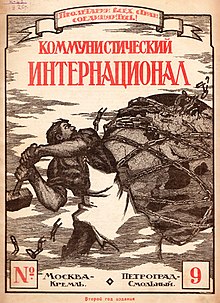Comintern
| Yn Eddyrashoonaght Chummynagh | |
|---|---|
 | |
| Bunneyder | |
| Ard-Scrudeyr | Georgi Dimitrov |
| Bunnit | 2 Mayrnt 1919 |
| Skeaylt | 15 Boaldyn 1943 |
| Roie-immeeaghtagh | |
| Eiyrtyssagh | Cominform |
| Pabyr naight | Yn Eddyrashoonaght Chummynagh |
| Çheu yn aegid | Eddyrashoonaght Chummynagh yn Aegid |
| Eie-oaylleeaght | |
| Spectrum politickagh | Feer chlee |

Yn Eddyrashoonaght Chummynagh (Comintern), ta enmyssit y Trass Eddyrashoonaght chammah, she reagheydys eddyr-ashoonagh va bunnit ayns 1919 dy heerloayr er son y chummynys dowanagh, as va stiurit liorish Partee Cummynagh yn Unnaneys Soveidjagh.[3][4][5] Ec e Nah Chohionnal ayns 1920, chiarail Comintern dy "streeu trooid dagh mean, goaill stiagh forse armit, er son toyrt-mow yn bourgeoisie eddyr-ashoonagh as crooaght pobblaght hoveidjagh eddyr-ashoonagh myr keim chaghlaaee roish slane scryssey yn steat".[6] Hie yn Nah Eddyrashoonaght roish Comintern ayns 1916.
Va shiaght Co-whaiylyn Dowanagh ec Comintern ayns Moscow eddyr 1919 as 1935. Car yn eash shen, stiur eh tree Laanyn Mooadit jeig jeh'n Ving Chiannoortagh stiuree echey, as cooid vie jeh ny currymyn echey v'ec ny Co-whaiylyn mooarey. Chur Joseph Stalin, toshiagh yn Unnaneys Soveidjagh, jerrey rish Comintern ayns 1943 dy haghney asschaarjys lesh e chochaarjyn ayns ny bleeantyn jeianagh jeh'n Nah Chaggey Dowanagh, ny Steatyn Unnaneysit as y Reeriaght Unnaneysit. Haink Cominform magh ayns e ynnyd ayns 1947.
Imraaghyn
[reagh | edit source]- ↑ Blanc, Paul Le (15 Averil 2015). Leon Trotsky (ayns English). Reaktion Books. dgn. 1–224. ISBN 978-1-78023-471-7.
- ↑ Allen, Barbara (8 Jerrey Geuree 2015). Alexander Shlyapnikov, 1885–1937: Life of an Old Bolshevik (ayns English). BRILL. dg. 233. ISBN 978-90-04-24854-0.
- ↑ Legvold, Robert (2007). Russian Foreign Policy in the Twenty-First Century and the Shadow of the Past. Columbia University Press. dg. 408. ISBN 978-0-231-51217-6.
However, the USSR created an entirely new dimension of interwar European reality, one in which Russia devised rules of the game and set the agenda, namely, the Comintern.
- ↑ Conquest, Robert (1990). The Great Terror: A Reassessment. Oxford University Press. dg. 399. ISBN 978-0-19-507132-0.
It became instead a set of parties founded strictly on the Bolshevik model, and constitutionally subordinated to the Comintern - which always remained under effective Soviet control.
- ↑ "Third International". Encyclopædia Britannica. Feddynit magh er 3 Nollick 2020.
Though its stated purpose was the promotion of world revolution, the Comintern functioned chiefly as an organ of Soviet control over the international communist movement.
{{cite web}}: Check date values in:|access-date=(cooney) - ↑ Fisher, Harold Henry (1955). The Communist Revolution: An Outline of Strategy and Tactics. Stanford UP. dg. 13.
- Comintern
- Reagheydyssyn cummynagh
- Shennaghys y toshiallys
- Eddyrashoonaghtyn y çheu chlee
- Politickaght feer chlee
- Mooinjerys joarree yn Unnaneys Soveidjagh
- Eddyrashoonaghtyn politickagh
- Reagheydyssyn Stalinagh
- Stalinaght
- Reagheydyssyn neu-reiltyssagh eddyr-ashoonagh anvio
- Politickaght yn Unnaneys Soveidjagh
- Yn Roosh ayns 1919
- Bunneeaghtyn 'sy vlein 1919
- Yn Unnaneys Soveidjagh ayns 1943
- Jee-vunneeaghtyn 'sy vlein 1943
- Reagheydyssyn bunnit ayns 1919
- Reagheydyssyn jee-vunnit ayns 1943
- Reagheydyssyn soshiallagh eddyr-ashoonagh
